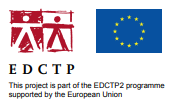
PROJECTS
This is a Career Development Fellowship, granted to Dr. Jane Francis Namukasa Wanyama with award number TMA2016CDF-1602. The study’s overall aim is to establish treatment outcomes, barriers and facilitators for linkage into care and adherence to ART among individuals initiating ART under “Test and Start” guidelines in five urban HIV clinics in Uganda. It is a mixed methods study combining both qualitative and quantitative methods. More
The CAPA-CT 2 project aims to generate knowledge relevant to the potential spread of the EVD outbreak in Democratic Republic of the Congo (DRC) to the Republic of Uganda. First, the project intends to improve knowledge of the mechanism of action of a prioritised drug by generating local clinical pharmacokinetic data that is needed for interpretation of pharmacokinetic data generated through MEURI, drug interactions with antiretroviral drugs and to inform future treatment optimisation approaches. More
The study proposal aims to build capacity for the detection and care of non-communicable diseases and geriatric syndromes the geriatric HIV positive population in sub-Saharan Africa.
HIV infected individuals are at higher risk of “non AIDS” complications such as multiple non-communicable diseases; non-communicable diseases also often increase with age. Additionally, HIV infection itself seems to be associated to an accelerated aging process, due to multiple factors such as chronic inflammation and long term drug exposure. More
HIV infected individuals are at higher risk of “non AIDS” complications such as multiple non-communicable diseases; non-communicable diseases also often increase with age. Additionally, HIV infection itself seems to be associated to an accelerated aging process, due to multiple factors such as chronic inflammation and long term drug exposure. More
The EDCTP-TDR Research & Development Fellowship supports researchers and key members of clinical trial research teams from Low and Middle Income Countries (LMICs) to acquire specific skills in clinical research and development through placements in pharmaceutical companies, product development partnerships (PDPs) and research institutions. Dr. Walimbwa was hosted for one year at the Novartis Institutes for Biomedical Research (NIBR) in Basel, Switzerland. More
Tuberculosis (TB) is a public health burden that causes substantial morbidity and mortality particularly in sub-Saharan Africa. Although there have been considerable advances in TB control new advances in TB treatment are needed. A growing body of evidence has indicated that the current dose of rifampicin (10mg/kg) is inadequate. Several studies have suggested that dose escalation (to 20-35mg/kg) is safe, and that higher doses (35mg/kg) may accelerate clearance of TB bacteria from the sputum of infected individuals. More
The use of Antiretroviral therapy for life among HIV positive pregnant women was recommended by WHO, referred to as Option B+. The success of Option B+ has been reported in many sub-Saharan countries and Mother to Child Transmission (MTCT) rates as low as 2.5% have been reported in Uganda. Despite the noted successes, high levels of attrition of mothers, particularly in the post-partum period, have been observed. More
The study to determine the optimal dose of atazanavir (boosted with ritonavir) when used in combination with rifampicin-based TB treatment in children, adolescents, and pregnant or breastfeeding women. More
This is a Senior Fellowship by Prof Pauline Byakika-Kibwika whose aim is to generate data to guide optimization of malaria treatment for individuals co-infected with HIV and malaria, by utilizing innovative interventions to overcome the significant drug interactions between artemether-lumefantrine and efavirenz. Previous studies demonstrated significant reduction in systemic exposure to artemether, its metabolite dihydroartemisinin, and the long acting partner drug lumefantrine when the ACT artemether-lumefantrine was co-administered with efavirenz-based ART. More
Lower Respiratory Illnesses are a leading cause of mortality globally and the treatment given is usually empirical based on epidemiological data and known or perceived antimicrobial susceptibility patterns. More


